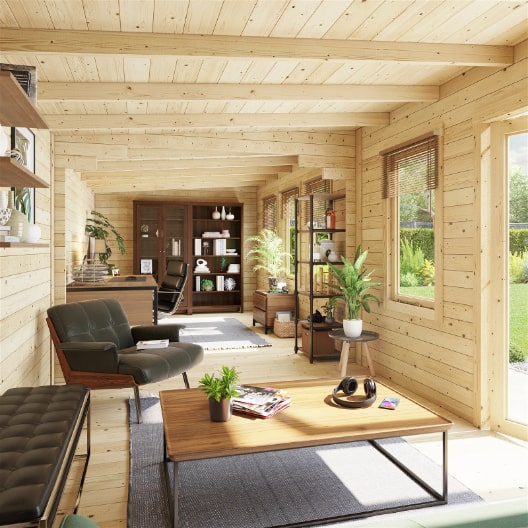Jump to:
Remote work and flexible job arrangements have become the new norm. And many still continue to adapt to working from home. In this context, a well-designed garden office is now more important than ever. If you find yourself in this situation, you’ve come to the right place.
In this guide, we’ll provide you with valuable tips on how to tailor yours to your specific job requirements. Read on to explore considerations and discover secrets to achieving a work-life balance.
Understanding Your Job’s Demands

This is your first step in creating a garden home office that caters to your professional needs. To begin, take a moment to reflect on the unique demands of your job.
What your needs are will depend on your specific profession. Consider the equipment you regularly use to tailor your workspace to your job. For instance, graphic designers may require high-performance computers and graphic tablets. Meanwhile, writers might need a comfortable ergonomic chair and a noise-cancelling headset.
Architects and engineers may rely on large drafting tables and specialised hardware. Whereas therapists could need comfortable seating and noise insulation.
Privacy is another key aspect to ponder. This is especially important if your job involves sensitive information. All in all, listing down all the things you need will serve as your blueprint. It will help you determine the necessary space, layout, and storage solutions.
Location and Orientation

The location of your outdoor office can profoundly impact your 1.) work environment and 2.) productivity. There are a couple of things you need to consider:
Sunlight
Optimal natural light is essential for a healthy and productive workspace. With ample sunlight, working in your shed office can help reduce eye strain and boost mood. In most cases, this approach can also save on lighting costs.
Accessibility
Consider how easily you can access your garden office. It should be situated as close to your home as zoning regulations and available space allow. This minimises interruptions and maximises convenience. To enhance accessibility, create a clear path to the office. Also, ensure easy access to amenities like the restroom or kitchen.
To make the most of your chosen location, take note of the following tips:
- Position windows strategically to capture the most daylight.
- Use light-coloured and reflective surfaces inside to enhance illumination.
- Ensure windows are easily operable for ventilation.
- Plant trees or install shades to regulate temperature during hot seasons.
Design and Layout

When designing your garden room workspace, choose a layout that aligns with your work. Consider the nature of your job and personal preferences when making this choice. Options include:
- open space for collaboration
- closed offices for focused work
- cubicles for a balance of privacy and interaction (take our garden office Kent, as a reference)
Note: Your decision may vary depending on the size of the building. You may, however, use these ideas to envision what you can do to maximise the available space you have.
Additionally, the selection of ergonomic furniture cannot be overstated. It directly impacts your comfort and productivity. Invest in a comfortable chair – this is a must regardless of what profession you have. For instance, one that features good lumbar support and/or adjustable armrests.
If your budget allows, opt for an adjustable or standing desk to reduce strain. Such factors enable you to accommodate computers and drawing tablets. Ergonomic keyboard and mouse systems and monitor risers come in handy for programmers. Proper indoor lighting also plays a vital role in setting the mood and reducing eye fatigue.
To foster productivity, personalise your space with inspiring decor, artwork, or plants. Incorporate a colour scheme that energises you. Create a dedicated area to showcase your achievements or works in progress. This not only motivates but also enhances your professional identity.
Plants can also enhance creativity and reduce stress. Incorporate greenery for a refreshing touch. Organise the room efficiently to minimise clutter and distractions. It should be a place that motivates you while ensuring comfort and functionality.
Connectivity and Technology
A stable internet connection is the backbone of remote work. It ensures seamless communication, video conferencing, file transfers, and access to online resources. An unreliable connectivity can lead to productivity losses and frustration.
To establish a reliable one, you have two main options:
- Wired network: Ethernet cables offer a direct and stable connection. Run cables from your home to the garden office. Use quality routers and switches for the best performance.
- Wireless network: Invest in a high-quality Wi-Fi router with strong coverage. Ensure it reaches your garden office with minimal interference.
For cable management, use cable clips, sleeves, and cable trays. These should get the job done in keeping wires organised and preventing accidents. A well-organised cable system also helps maintain a neat workspace and prevents distractions.
Storage and Organisation

A clutter-free garden office is essential for maintaining focus and productivity. On top of keeping the space organised, it also helps you find what you need quickly. To achieve this, you need to implement storage options and organisation.
You may install vertical shelves for books and documents. Drawers and cabinets come in handy for art supplies. A flat-file cabinet is excellent for storing blueprints; filling cabinets for patient records.
If you plan to use containers and shelves, label them. Use transparent bins for easy viability. For smaller items, you can never go wrong with wall-mounted organisers like pegboards.
Achieving Work-Life Balance

A work-life balance is important, regardless of your profession. Now that you work so close to your home, aiming for this goal may become more attainable. To maximise your new workspace while maintaining a healthy balance:
- Set boundaries: Establish clear working hours and stick to them. Avoid overworking, and don’t let work spill into your personal time.
- Designated workspace: Create a distinct workspace within your garden office. This technique will help you separate work from leisure. Use physical or visual barriers to define the boundaries. Invest in a dedicated desk or work area or use room dividers. You may also position your desk so it faces away from personal areas to create a clear boundary.
- Take breaks: Schedule short breaks to recharge. Step outside, enjoy the garden or simply relax for a few minutes.
- Stay organised: Keep your garden office clutter-free, with a place for everything. Organised surroundings can lead to a clear mind.
- Healthy lifestyle: Incorporate healthy habits into your daily routine. For one, regular exercise and a balanced diet can boost your energy and focus.
- Time for family and friends: Dedicate time to spend with loved ones. Arrange breaks and leisure moments to align with your family’s schedule.
- Unplug after work: At the end of your workday, turn off work-related devices. Disconnect from professional communication. Enjoy your personal time.
Round-up
Congratulations! You’ve taken a significant step toward work-life balance and enhanced productivity. Your garden office now becomes the foundation for a fulfilling remote experience. Here’s to a future of achievement and balance in your newly transformed workspace!
If you’re still searching for the right building, Garden Buildings Direct has you covered. Discover our collection of insulated garden office units, like this versatile office shed.
Next on your reading list: An Insulated Garden Office: Is It Really Worth It?










